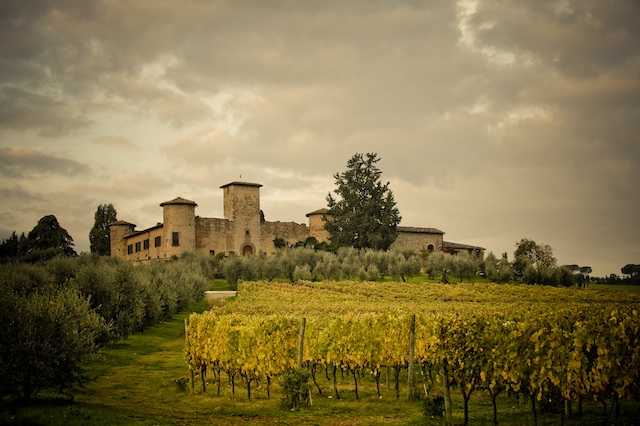
Castello di Gabbiano. Photo courtesy of Castello di Gabbiano.
There are few destinations in the world more synonymous with gastronomy than Tuscany. Chianti Classico wine, rich olive oil, flavors that come from fragrant herbs and spices, crusty breads, decadent truffle and Pecorino cheeses are just a few of the delicious images that swirl through any Tuscan fantasy. While you can simply book a flight to Tuscany and blindly eat your way through the region, a smarter idea is to fill your itinerary with special epicurious experiences that can help immerse you in local culture. To help you plan your trip, here are some top Tuscany wine and food experiences.
Stay At Castello di Gabbiano
A restored 12th-century castle turned luxury hotel, Castello di Gabbiano features three farmhouse apartments, 11 unique castle rooms and an abundance of agritourism experiences in a Tuscan countryside setting. Located in the heart of the Chianti Classico region, Castello di Gabbiano is one of the original estates to produce this iconic Tuscany wine, with many bottles still crafted using traditional recipes and methods. The property became a farm in the 14th century, with its wine production starting during this time, as well. Guests can enjoy traditional Tuscan cooking classes, vineyard touring, wine tasting, local food and wine pairing, olive harvesting and pressing, and truffle hunting.
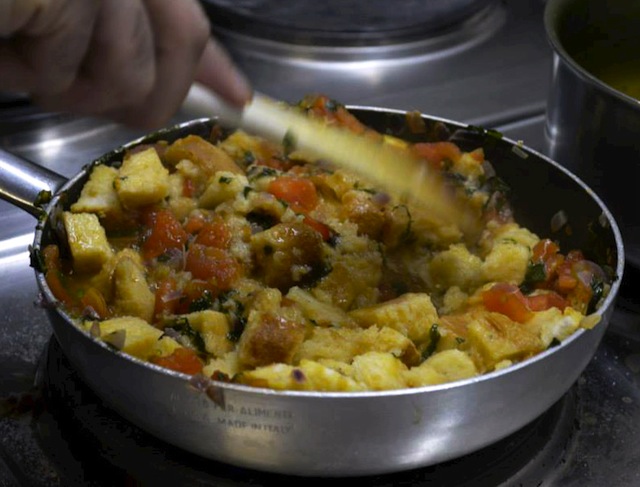
Making traditional Pappa al Pomodoro with Chef Francesco at Castelfalfi.
Partake In A Traditional Tuscan Cooking Class
As mentioned above, Castello di Gabbiano — about 20 minutes outside Tuscany — offers cooking classes that introduce visitors to the flavors of traditional Tuscan cooking. Executive Chef Paolo Nucera will teach you through the tongue about the importance of olive oil in dishes — including desserts — as well as using garden herbs and fresh ingredients. Simple meals become culinary journeys, as estate wines complement homemade flavors. A sample menu might include handmade pasta, chic pea soup, artichoke salad, Pollo Al Mattone (chicken under bricks) and olive oil cake, paired with Tuscany wine for the full experience. Cooking courses at Castello di Gabbiano vary by class and package. Check the website for details.
Depending on your location in Tuscany, a traditional Tuscan cooking class with Chef Francesco Ferretti of Tuscany’s Il Rosmarino at Castelfalfi, located in Montaione, about an hour outside Tuscany. He’ll teach you how to cook traditional recipes by hand — just like his grandmother taught him — with the menu including Peposo di Manzo, Pappa al Pomodoro and Cantucci Biscuits with sweet wine for dipping. You’ll leave with an understanding of peasant-style cooking, how herbs and spices influence flavor and Tuscan culinary heritage. A traditional Tuscan cooking class at Il Rosmarino is 90 Euros (about $120 USD).
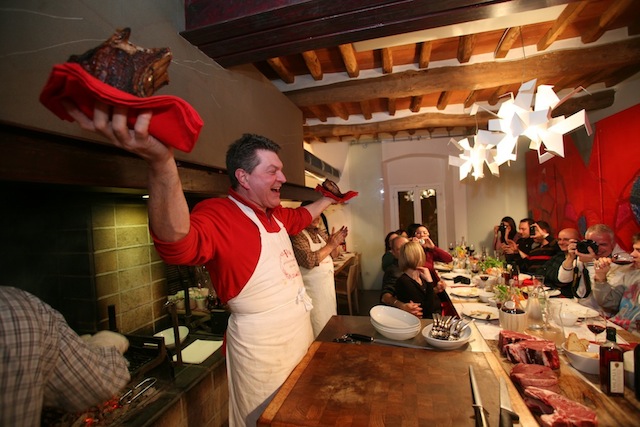
These guys love their meat! Photo courtesy of Officina della Bistecca.
Officina Della Bistecca
“Abandon hope all ye who enter, for you are now in the hands of a butcher.” You’ll find this quote at the top of your menu at Officina Della Bistecca in Panzano in Chianti, a meat-only restaurant and butcher shop. Downstairs the venue serves a complimentary aperitivo with local wine and Italian snacks like salami, lard spread, olives and bread. Next head upstairs for their fixed- price meat-themed dinner, including five different cuts of meat, vegetables, Tuscan bread, Tuscan beans with olive oil, a baked potato with Chianti butter (lard) and olive oil cake. Expect lots of wine, grappa and Italian cordial as well as inspirational meat-inspired speeches with quotes like “to beef or not to beef.”
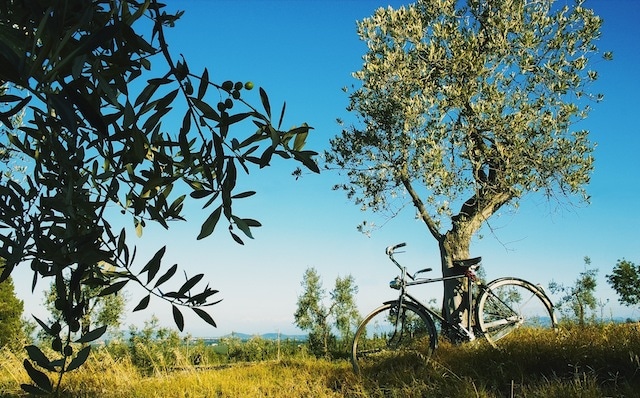
Olive trees in Tuscany. Photo courtesy of Castelfalfi.
Learn The Art Of Olive Oil Making
If there was one ingredient that had to be named as most important in Tuscan cooking, it would undoubtedly be olive oil. Tuscany’s rolling hills are littered with olive trees, mainly producing the varieties of Moraiolo, Pendolio, Frantoio, Taggiasca, Leccino and Maurino. While foreigners typically assume all olive oil is essentially the same, the truth is the consumer is terribly uninformed when it come to the product. While you can simply visit traditional restaurants to sample the local delicacy, a better idea is to visit a mill where olive oil is produced. Both Castello di Gabbiano and Castelfalfi offer this experience, allowing you to see exactly how the olives are made into oil from start to finish. Interestingly, only 10% of an olive is used for oil, while the rest is turned into waste and used as fertilizer. To further enhance your knowledge, add on one of the above-mentioned cooking classes.

Piazza del Vino
Have A Drink At Piazza del Vino
Piazza del Vino in Florence is a new concept in Tuscany, as it focuses more on the wine than the food. That being said, the food is outstanding compared to anything you’ve tried outside of the region. Over 200 brands are represented on the wine listed, with thousands of bottles lining the shelves. Order a bottle off the menu — which focuses mainly on Italian varietals from different regions — or walk over to the self-serve machine for wine by the glass. If you’re a regular, it makes sense to reserve your own miniature wine cellar at the restaurant, with staff being able to have your table and bottles ready when you come. Pair your drink with one of their dishes representing traditional recipes from all over the country, and watch as it’s made in their open kitchen. Some menu highlights include Fiorentina steak, baked suckling pig with raw vegetables, tortello pasta with potatoes and chunky meat sauce, and octopus soup. Best of all, you can watch your meal being cooked through their open kitchen. Knowledgeable servers can help you perfectly pair your meal and wine.

A vertical wine tasting at Castello di Gabbiano.
Going Beyond Standard Wine Tasting
At Castello di Gabbiano’s winery they offer structured wine tastings and food and wine pairings; however, there are also less standard offerings on the menu, like vertical tastings, barrel tastings and blind tastings. In a vertical tasting, you’ll get to sample an array of vintages of one wine varietal from a single producer, which allows you to see how a particular wine evolves each year. During a barrel tasting, instead of sampling a varietal from the bottle you’ll enjoy it straight from the barrel, before its finished aging. These wines tend to harsher, more tart and less smooth, although it’s an insightful experience as the winemaker discusses what made them choose which grapes and what they hope for the final product. And during a blind tasting, you’ll have the chance to sample wines without seeing the labels so you can experience the wine in an unbiased fashion.

Pecorino cheese is a specialty of Tuscany
Tour A Dairy Farm
No trip to Tuscany would be complete without experiencing the region’s Pecorino cheese culture. Pecorino cheese is a hard cheese made with whole sheep’s milk, and it comes in different varieties and styles. While you could sample the cheese at a local restaurant, a more immersive experience is visiting a dairy farm. Farmhouse Cretaiole is one option, as this agritourismo allows guests to watch the cheese-making process, as well as see baby animals, go wine touring and learn about olive pressing. There are also a number of tours offering excursions to working dairy farms, for example, a Cheese Making and Tuscan Olive Oil Tour with Scenic Wine Tours in Tuscany; a Secrets of Tuscany Tour with Food & Wine Vacations; or a Cheese, Salami and Olive Oil Tour of Tuscany with Tours By Locals.
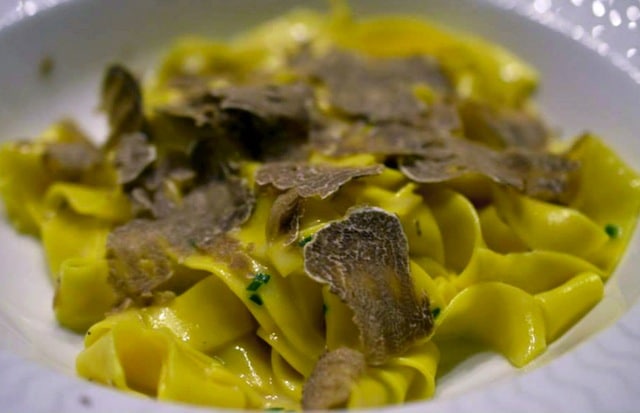
A fresh egg tagliatelle topped with the highly-prized local white truffle at Castello di Gabbiano.
Go Truffle Hunting
No place in the world is more synonymous with decadent truffles than Tuscany. White truffle is particularly special, as it’s the world’s most expensive fungus at $7 to $11 per gram, or $3,000 to $5,000 per pound. Instead of just trying the delicacy at a restaurant, gain a better understanding of the local culinary culture by going truffle hunting with a local truffle hunter, who will show you how to find truffles in the woods and how to best use them. Truffle Hunter is a great resource for this, offering a variety of relevant tasty experiences including a Chianti and Truffle Tour; Truffle Walking Tour; Wine & Truffle Tour; Florence Truffle Luxury Tour; and a Truffle Cooking Lesson.
Have you ever visited Tuscany? What were the food and drink highlights of your trip?
Featured image via Castello di Gabbiano

Jessica Festa is the editor of the travel sites Jessie on a Journey (http://jessieonajourney.com) and Epicure & Culture (http://epicureandculture.com). Along with blogging at We Blog The World, her byline has appeared in publications like Huffington Post, Gadling, Fodor’s, Travel + Escape, Matador, Viator, The Culture-Ist and many others. After getting her BA/MA in Communication from the State University of New York at Albany, she realized she wasn’t really to stop backpacking and made travel her full time job. Some of her most memorable experiences include studying abroad in Sydney, teaching English in Thailand, doing orphanage work in Ghana, hiking her way through South America and traveling solo through Europe. She has a passion for backpacking, adventure, hiking, wine and getting off the beaten path.








